Animal Phylogeny Lab - Practical 1
1/267
There's no tags or description
Looks like no tags are added yet.
Name | Mastery | Learn | Test | Matching | Spaced |
|---|
No study sessions yet.
268 Terms
Label the direction of time, root, node, branch, clade, and tip on a phylogenetic tree
direction of time pointed to the right
tip should be taxon
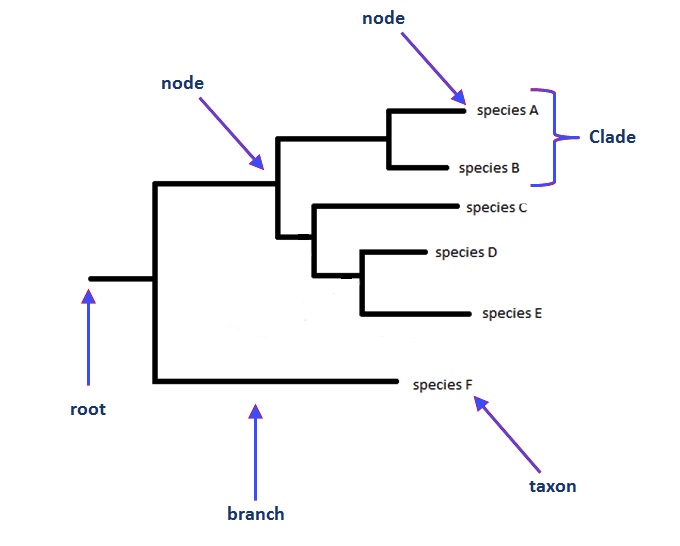
What is the principle of parsimony?
Choosing the simplest explanation to account for observations
What is the dorsal side?
Toward the back of the body
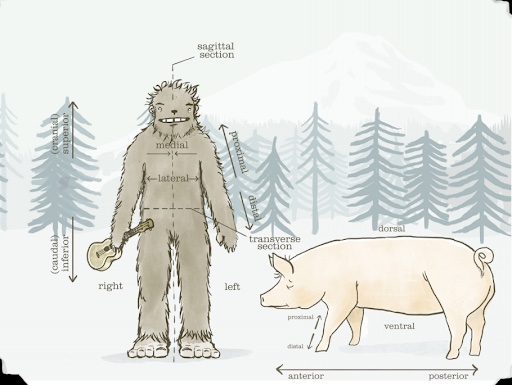
What is the ventral side?
toward the “belly” of the body
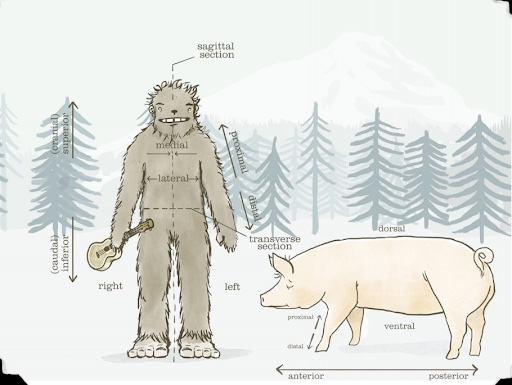
What is the medial side?
If the body is divided into right and left halves, the medial is toward the midline
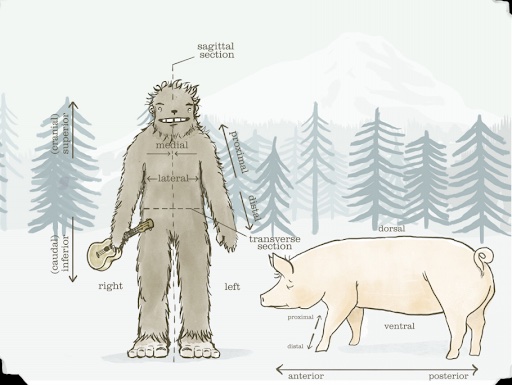
What is the lateral side?
If the body is divided into right and left halves, the lateral is away from the midline

What is the cranial (or rostral) side?
Toward the head

What is the caudal side?
Toward the tail
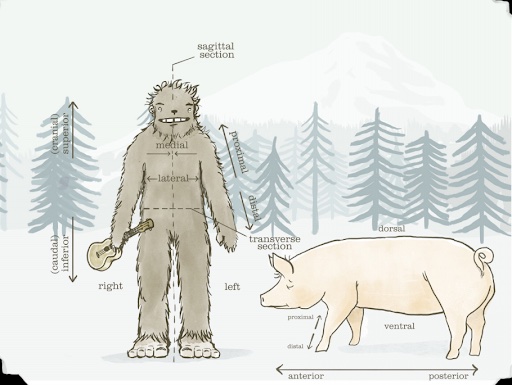
What is the proximal side?
Toward the core of the body
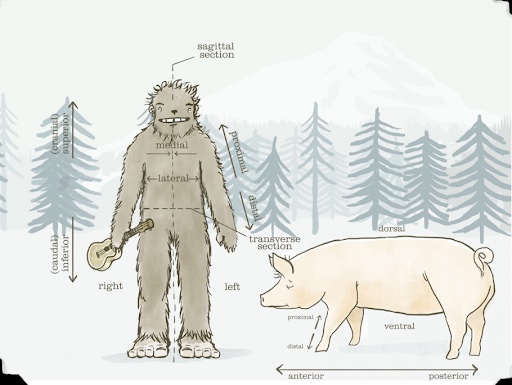
What is the distal side?
Away from the core of the body
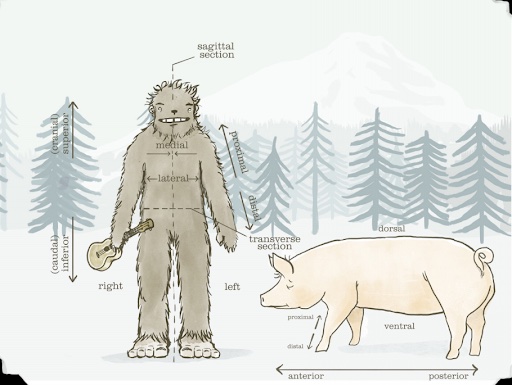
What is the superficial side?
Toward the body surface
What is the deep side?
Away from the body surface
What is the anterior side?
If you place an organism in its normal posture, the anterior side is the direction it would normally move
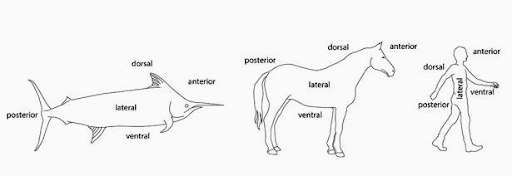
What is the posterior side?
If you place an organism in its normal posture, the posterior side is the opposite side than the direction it would normally move
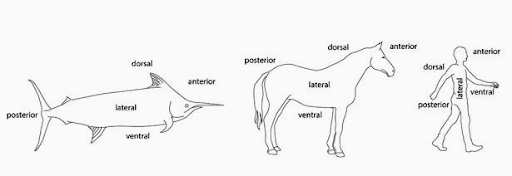
What is the superior side?
If you place and organisms in its normal posture, superior is toward the top-half
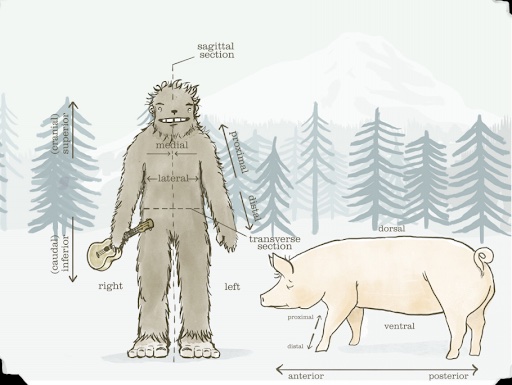
What is the inferior side?
If you place and organisms in its normal posture, inferior is toward the bottom-half
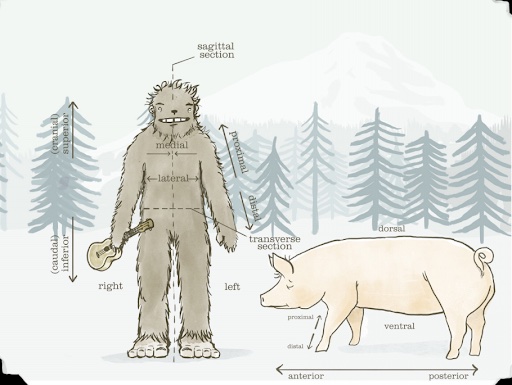
What is the midsagittal body plane?
Cut the body lengthwise (down the middle) dividing it into left and right halves
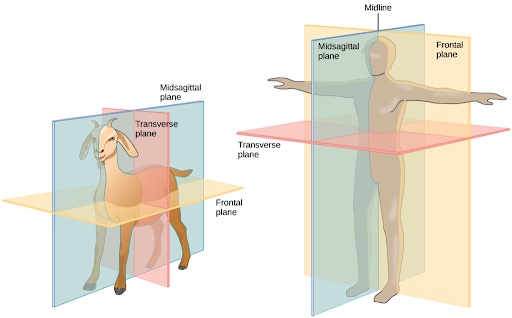
What is the transverse body plane?
Cut the body into cranial and caudal parts; produces cross-sections

What is the frontal body plane?
Cut the body into dorsal and ventral parts
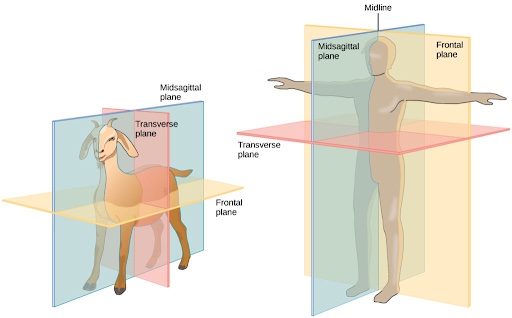
What is a dissecting microscope?
A microscope with lower magnification (7-40x) and intended for viewing objects ~1mm or larger; can be used with 3D specimens; specimens can be manipulated/dissected while viewing through the objectives; two lights (one transmitting light from underneath the specimen and one shining light down from above) allow use for translucent or opaque specimens
What is a compound microscope?
A microscope with higher magnification (40-400x); used with specimens mounted on slides, usually smaller than 1mm; ideal for observing unicellular or very small organisms, cells, and cell structures; since light is only transmitted through the specimen, they must be translucent.
What is the base of a microscope?
the bottom of the microscope, which supports the entire instrument
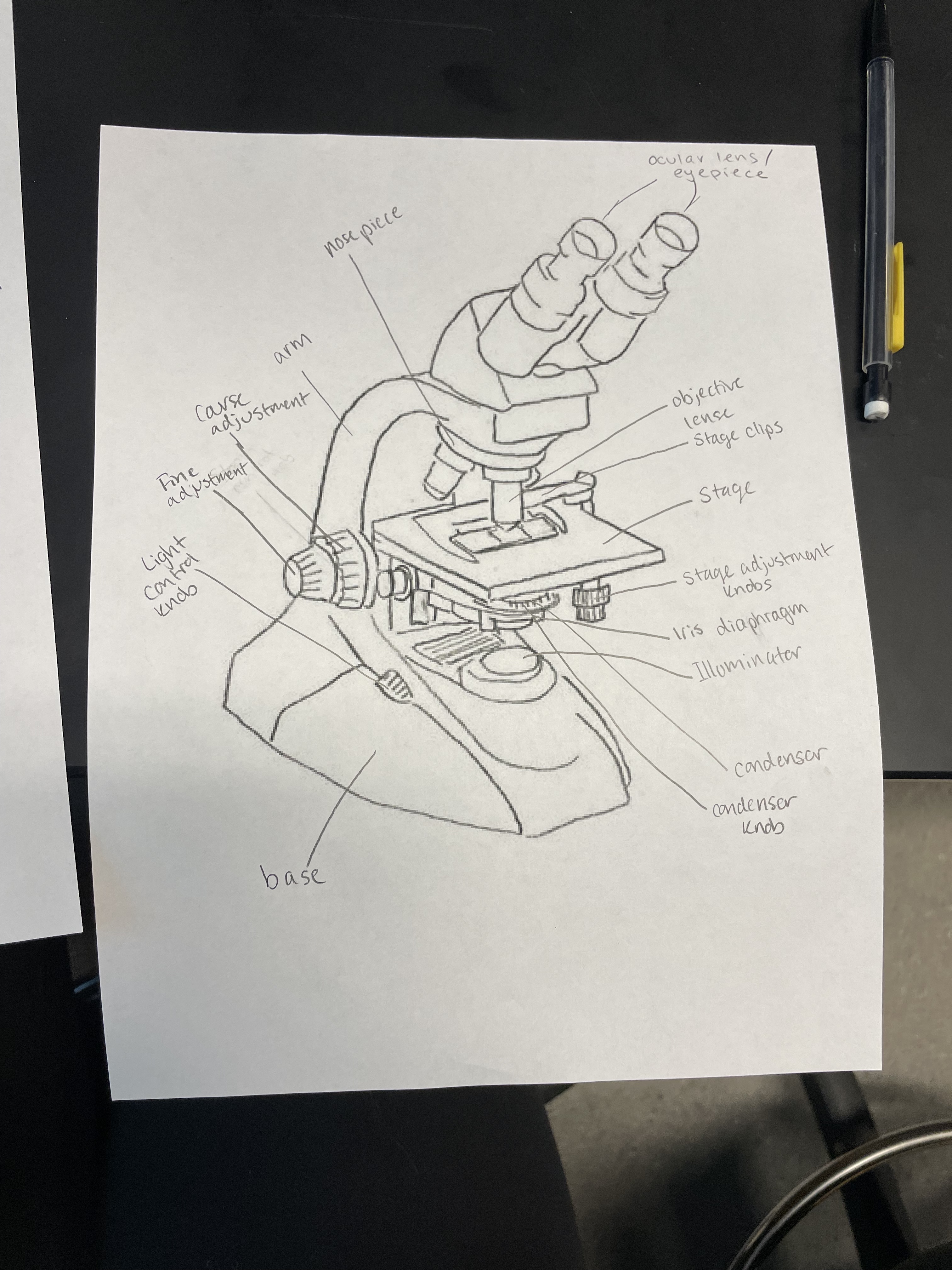
What is the illuminator or light source of a microscope?
the light source is usually built into the base of the microscope and directs light up through the condenser to the specimen. Some microscopes allow you to adjust the intensity of light with a
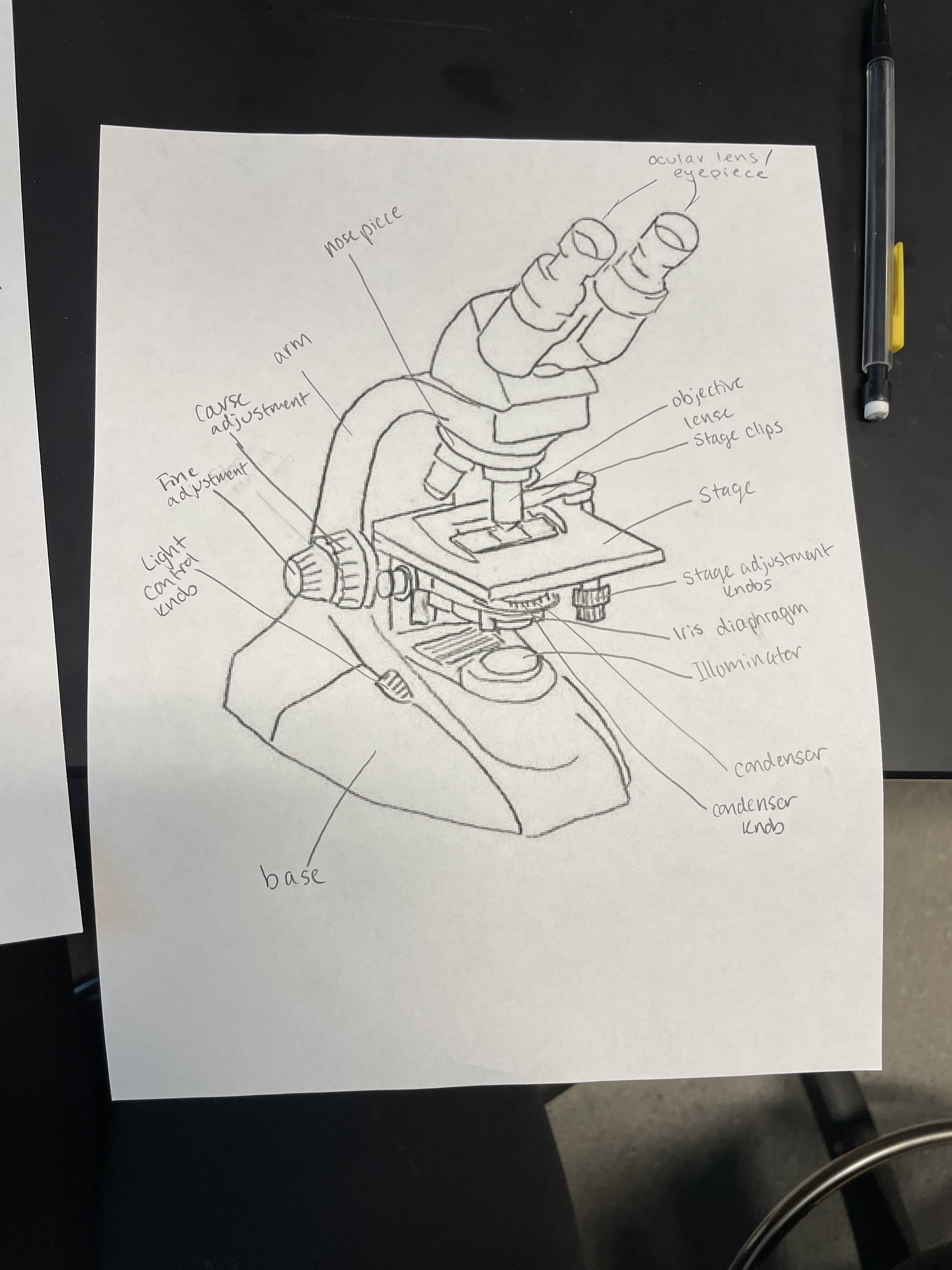
Where is the rheostat (light) control knob of a microscope?
on the left side of the base. Dissecting microscopes have an additional light source
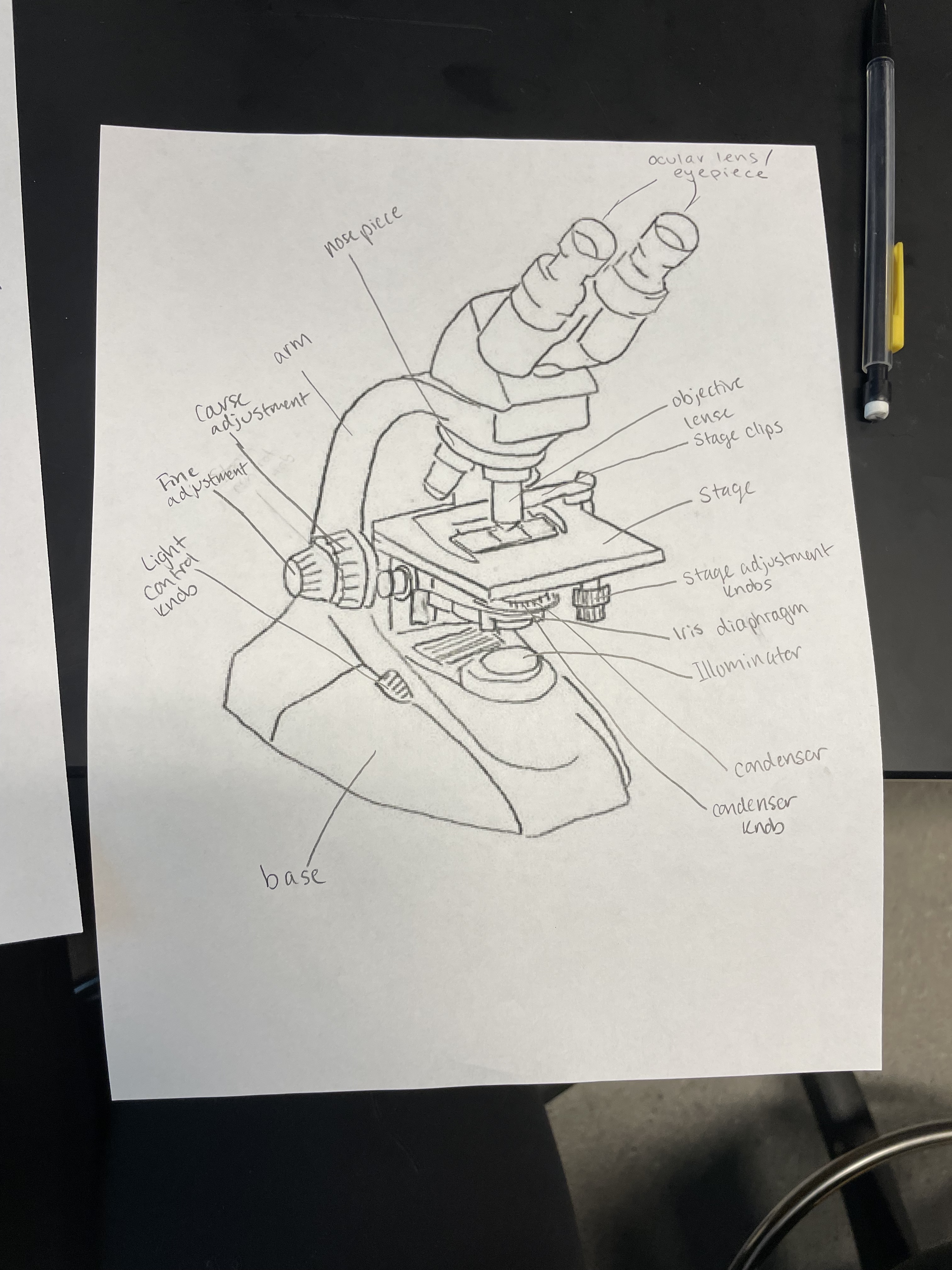
What does the incident light on a dissecting microscope do?
directing light downward to the base.

What is the arm of a microscope?
the frame that supports all components above the base. Microscopes should be carried by supporting the base and arm.
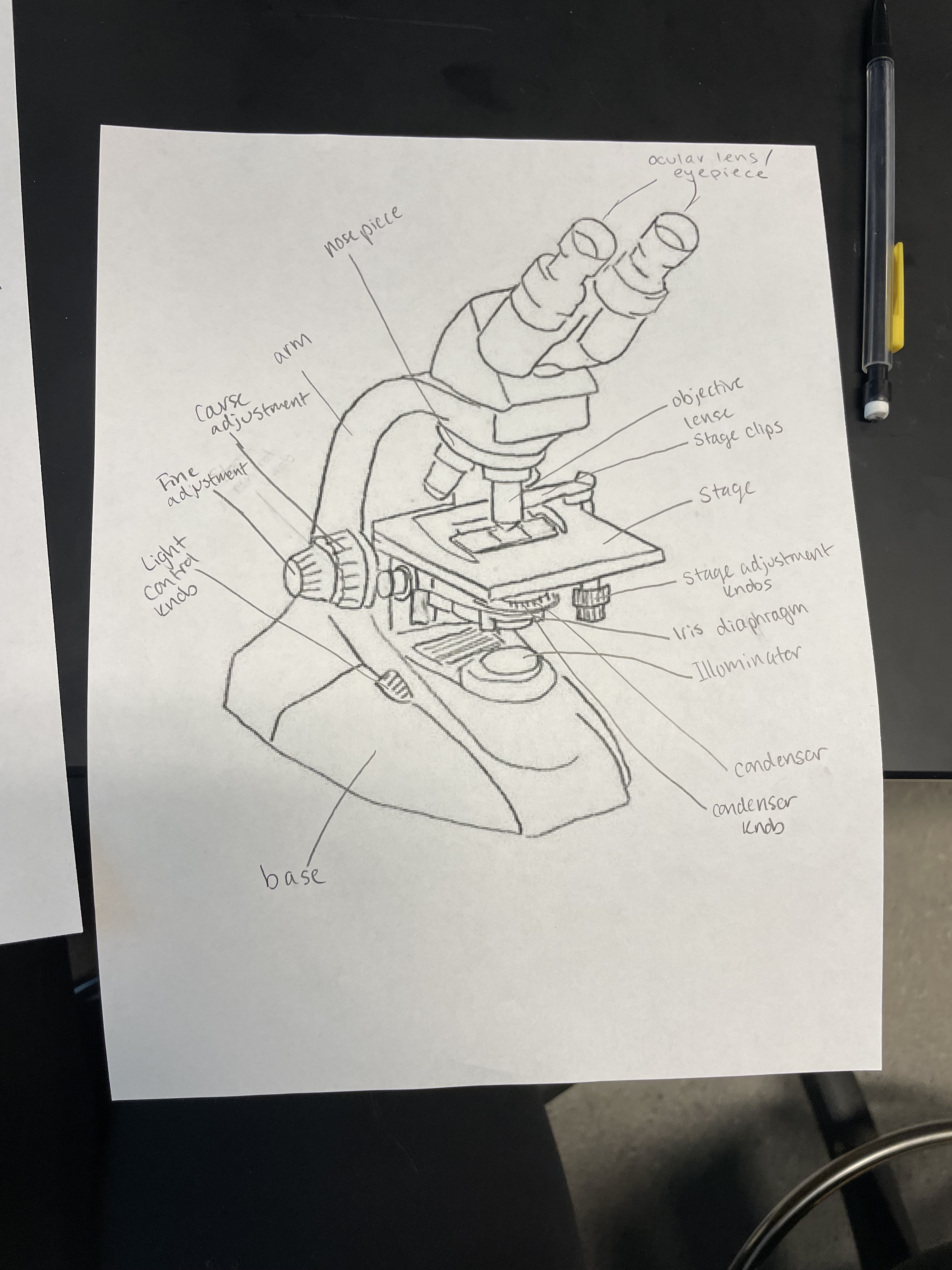
What is the revolving nosepiece or turret of a compound microscope?
a revolving disc-shaped support or frame for the objective lenses on a compound microscope. Dissecting microscopes have only one lens, so there is no turret.
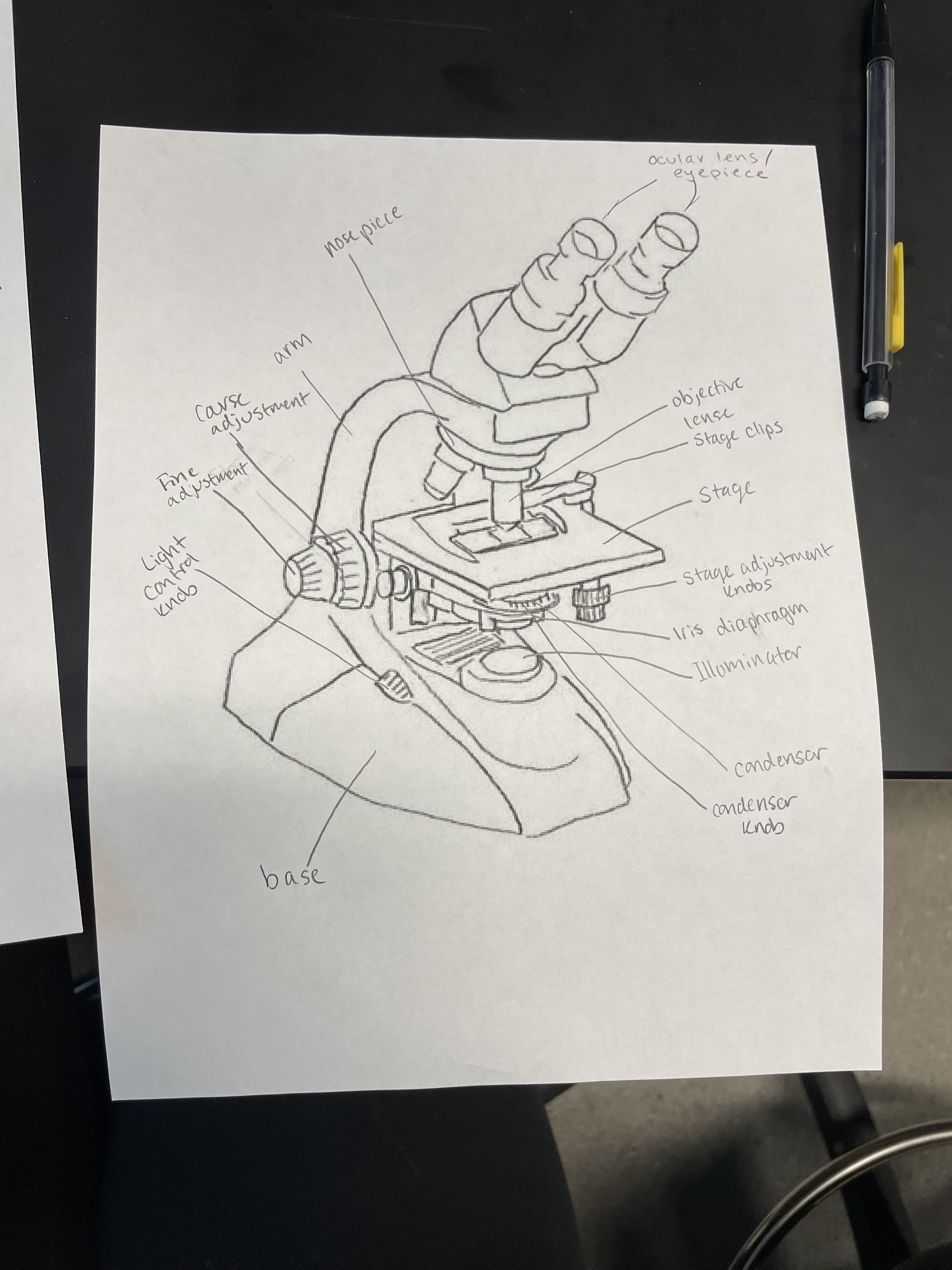
What is the objective lenses of a compound microscope?
the primary optical system which produces a magnified image of the specimen. There are typically four objective lenses attached to the nosepiece: a 4X scanning objective, a 10X low power objective, a 40X high power (dry) objective and a 100X oil immersion objective. The magnification of each objective is engraved on its side. Since the ocular lens of a compound microscope magnifies the image 10x, the total magnification is the objective magnification times 10 (e.g. 4x objective = 40x magnification).

What is the zoom control knob on a dissecting microscope?
adjustment knob for changing magnification

What is the ocular lens or eyepiece of a microscope?
the tube(s) that you look through. A binocular microscope has two ocular lenses and a monocular microscope has one ocular lens. NOTE: binocular lenses are customizable to your eyes. The two lenses swing to a narrower or wider eye width. One of the lenses can be focused separately – so you would adjust the focus knob for the stationary lens, then adjust the modifiable lens for a sharp image.
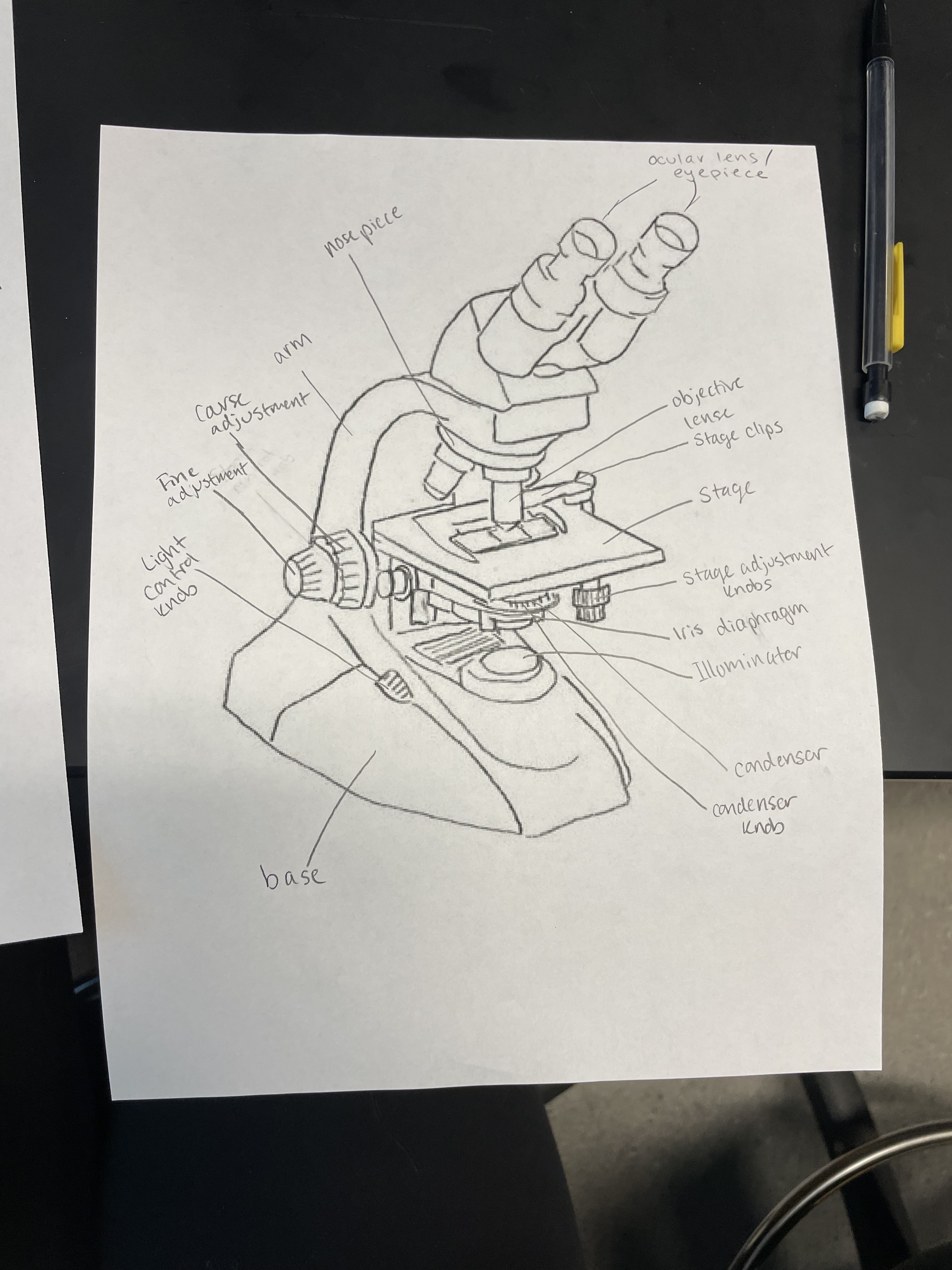
What is the stage of a microscope?
the flat surface upon which the slide with your specimen is placed. Most compound microscopes have
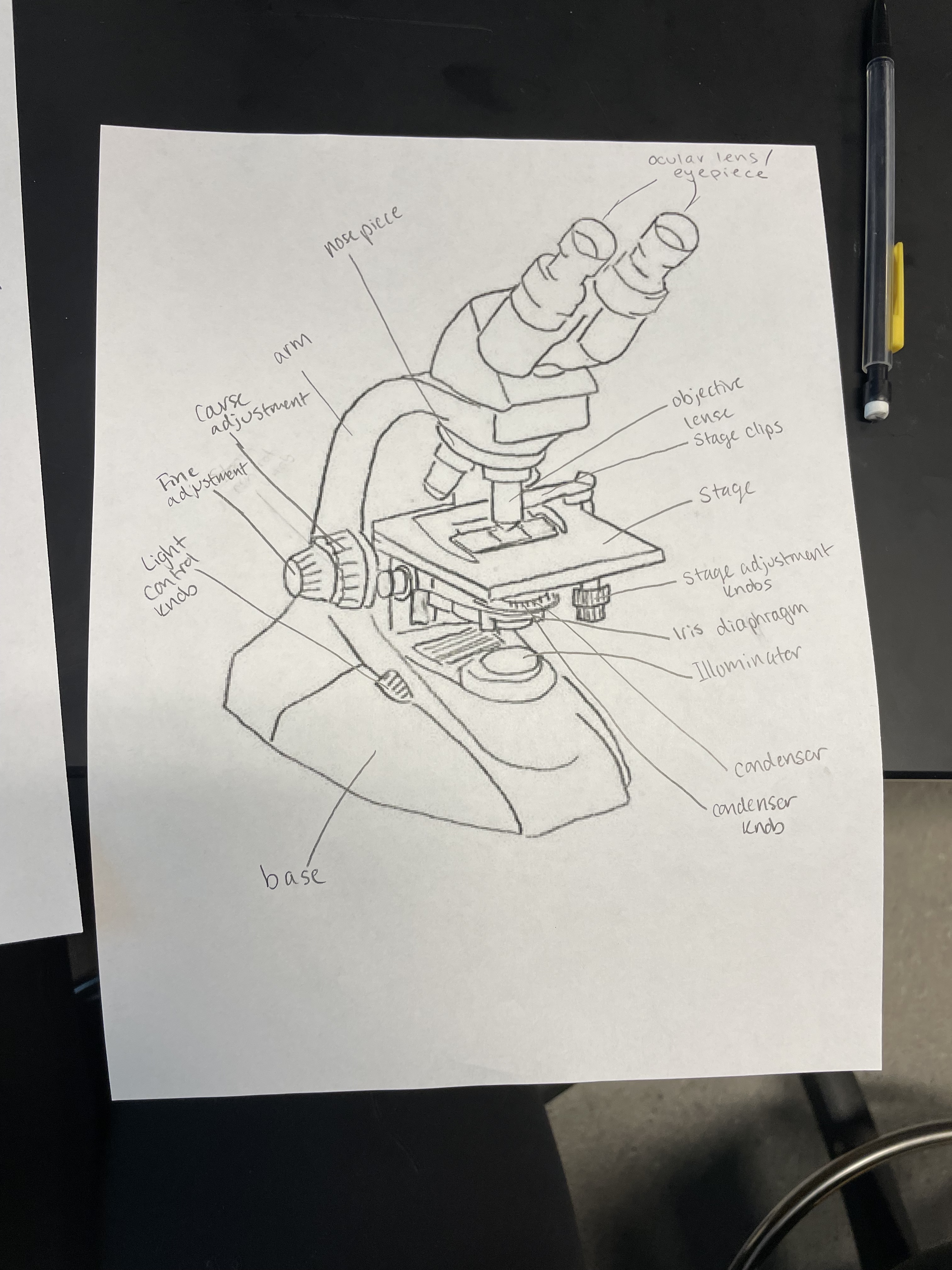
What are stage clips on a compound microscope
Used to hold and move the slide on the stage. Most professional microscopes have them
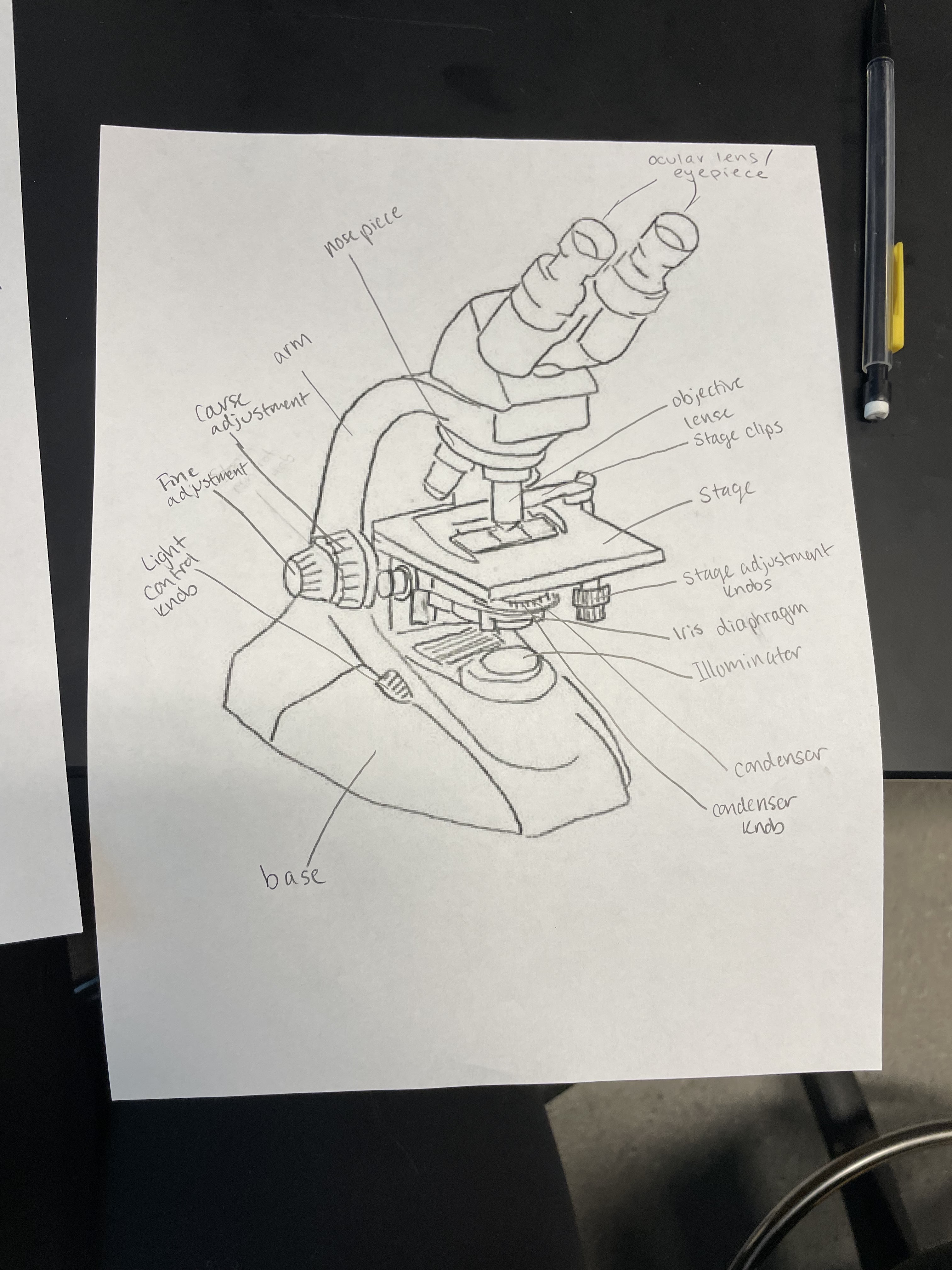
What are the stage adjustment knobs on a compound microscope?
to move the entire mechanism, including the slide, left/right and forward/back. Other microscopes require you to move the slide or specimen around on the stage. Keep in mind that compound microscopes reverse the image.
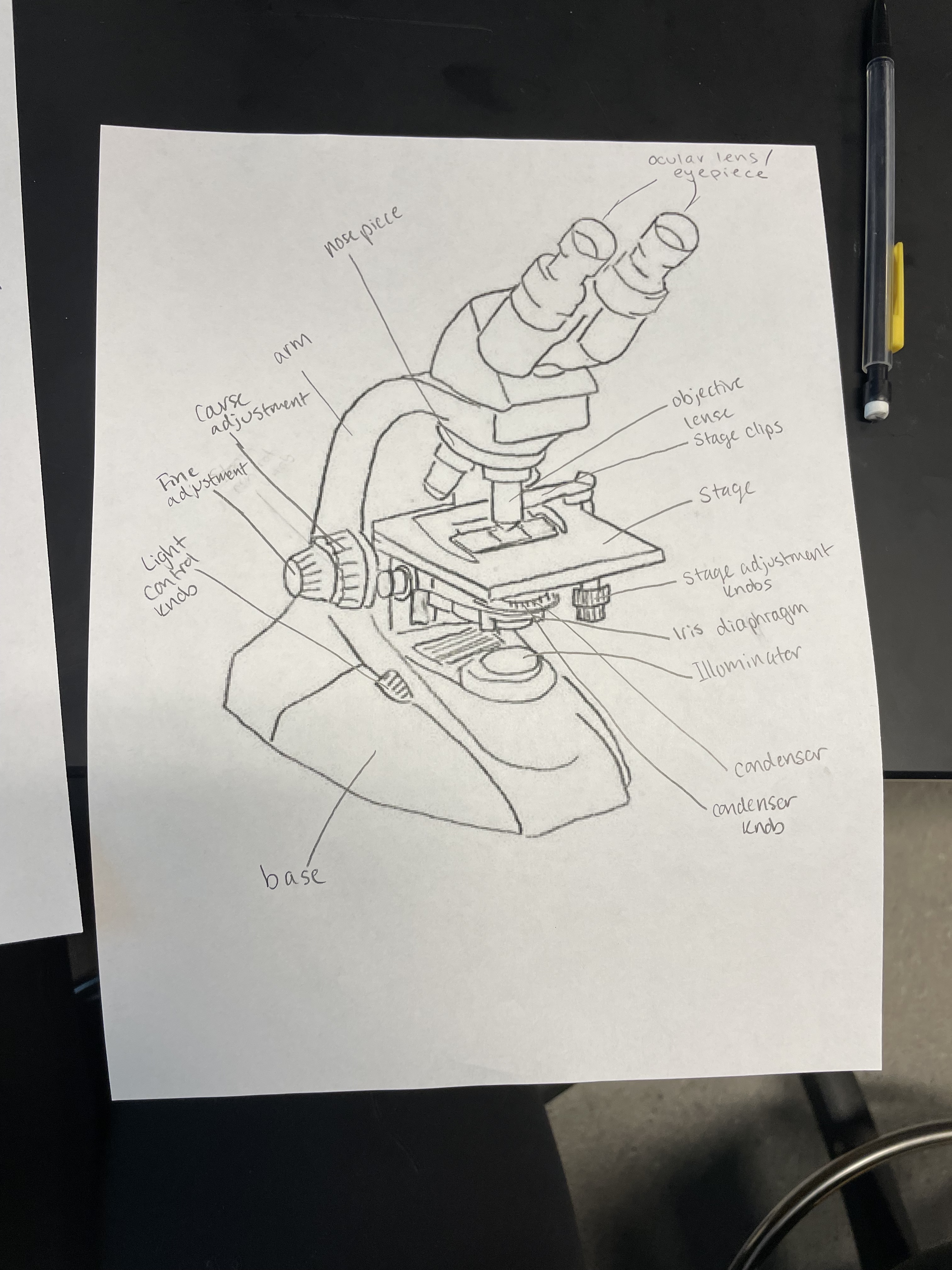
What is the condenser on a compound microscope?
the lens located below the stage focuses light (from the illuminator) through the specimen being observed. Many microscopes have a moveable condenser allowing its distance from the specimen to be adjusted using a condenser knob and condenser alignment screw *look for these too
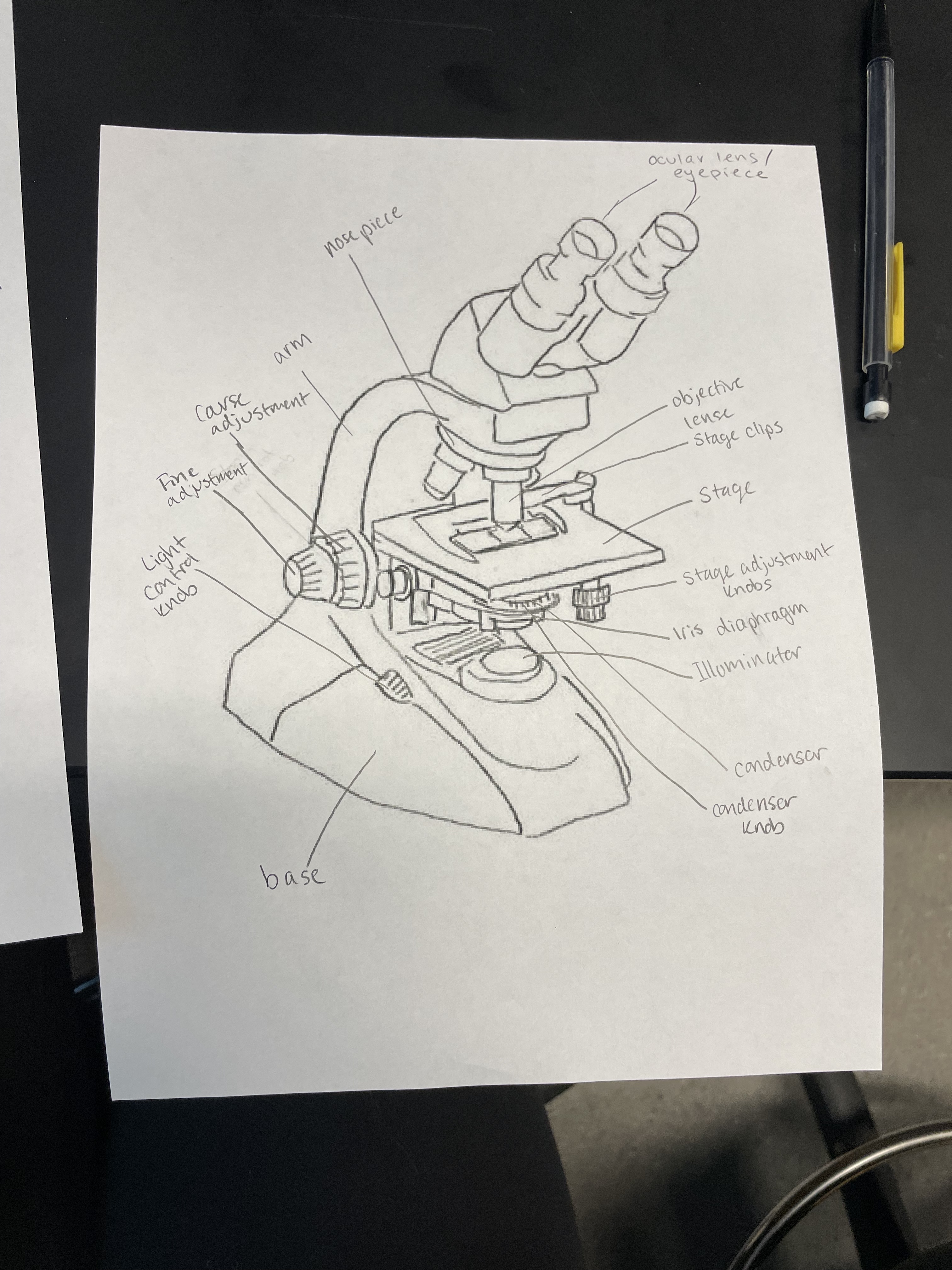
What is an iris diaphragm on a compound microscope?
a unit below the condenser that controls the amount of light directed to the specimen. The diameter of the diaphragm can be adjusted by turning it to increase or decrease the size of the hole that light passes through.

What is a coarse adjustment or coarse focusing knob on a microscope?
the large knob towards the back of the instrument that is used to significantly raise or lower the stage, when you first focus on a specimen at low power. USE THIS KNOB FOR 4x OBJECTIVE ONLY. NEVER USE THIS KNOB WHEN USING 10x, 40x, or 100x OBJECTIVES. On the dissecting microscope, the focus knob moves the head of the microscope up and down to adjust the sharpness of the image.
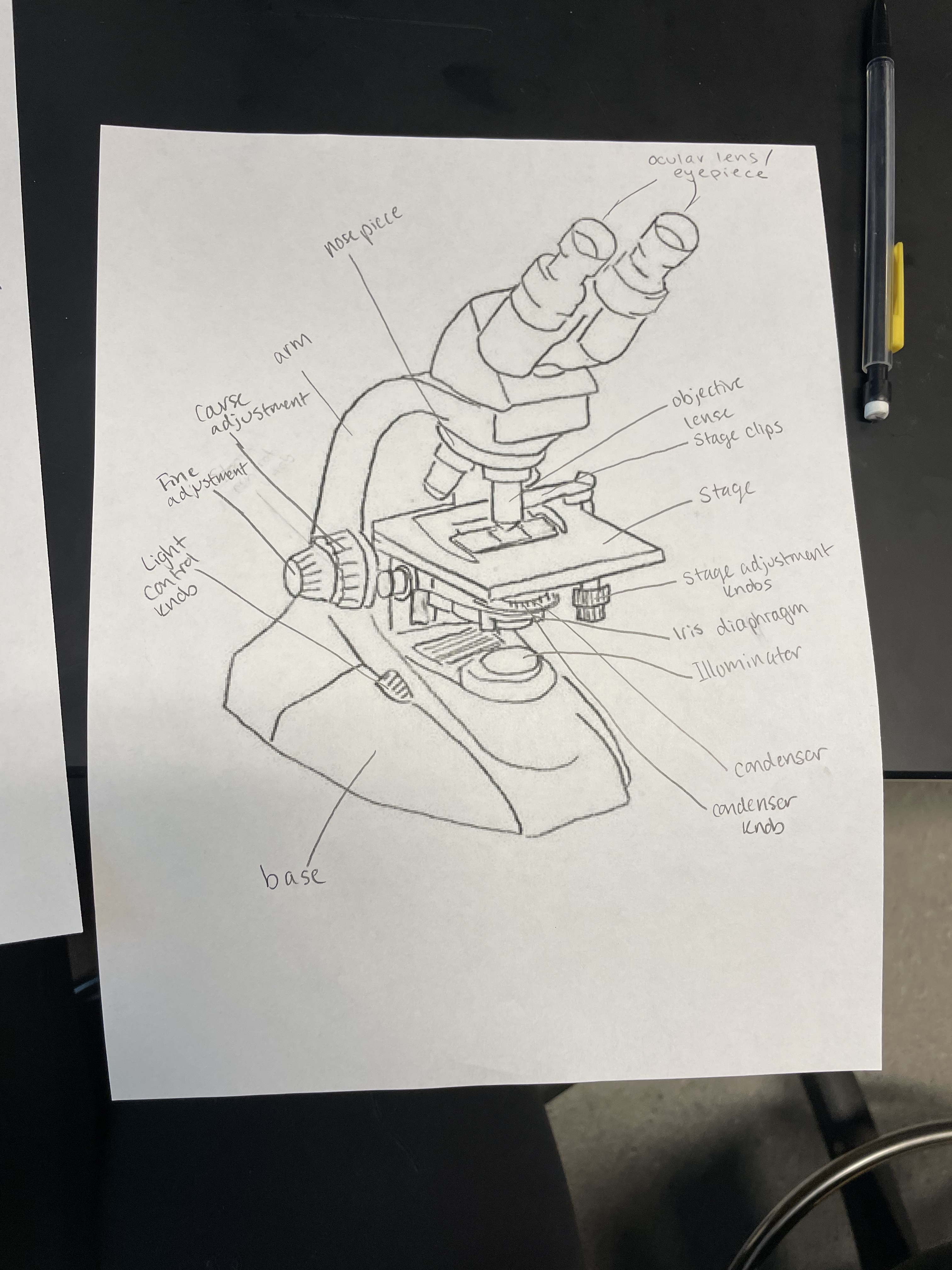
What is the fine adjustment or fine focusing knob on a compound microscope?
the smaller knob projecting out from the course focus knob is used to make small adjustments in the height of the stage for final focusing on a specimen. It is the only focusing knob used with high power objectives.
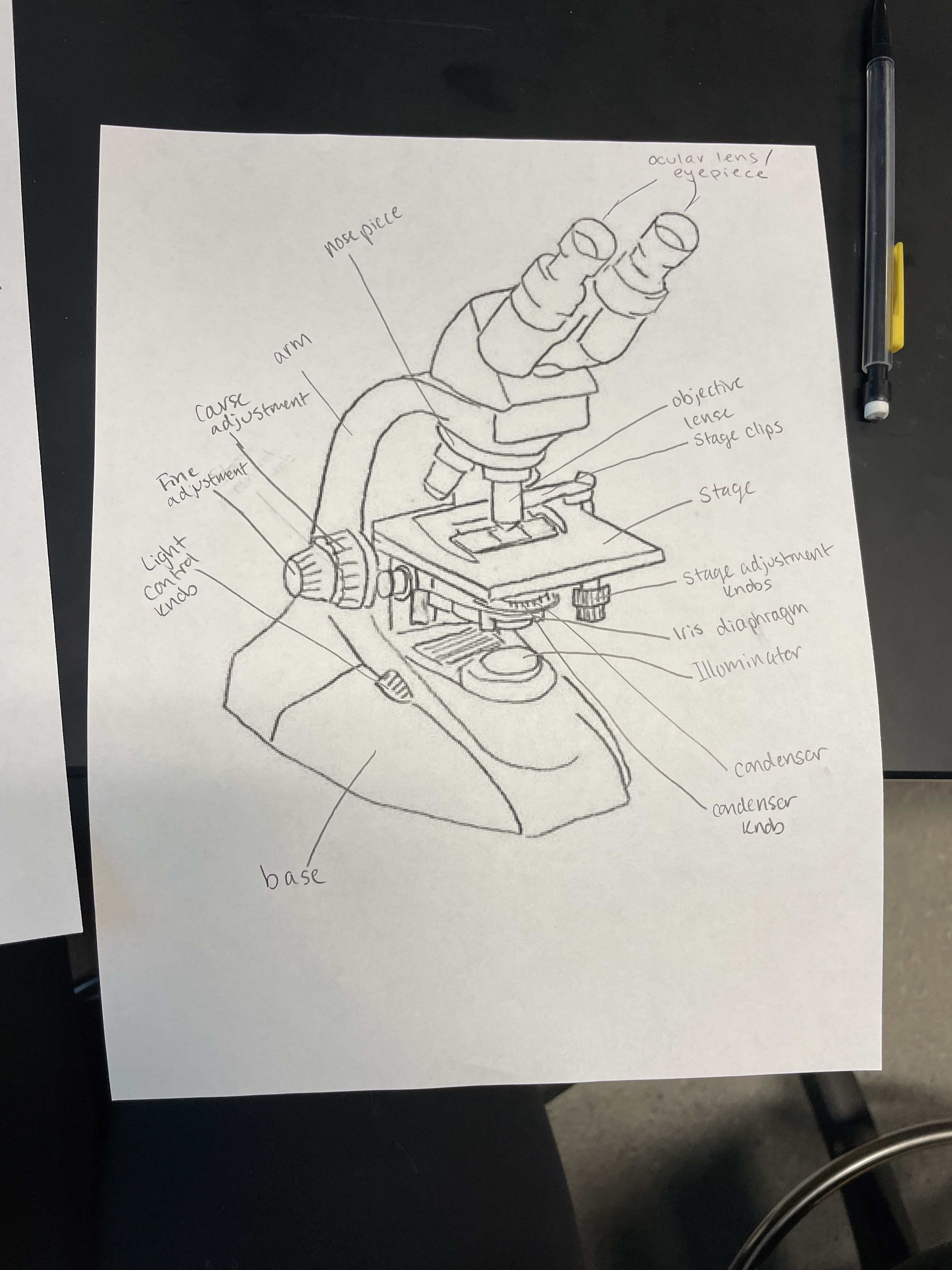
What are some characteristics of the phylum porifera?
Porifera are asymmetric and have spicules or spongin. They also have pores and canals which allow water to circulate through them, thus they are suspension feeders.
What are the three sponge body forms?
Asconoid, Synconoid, and Leuconoid
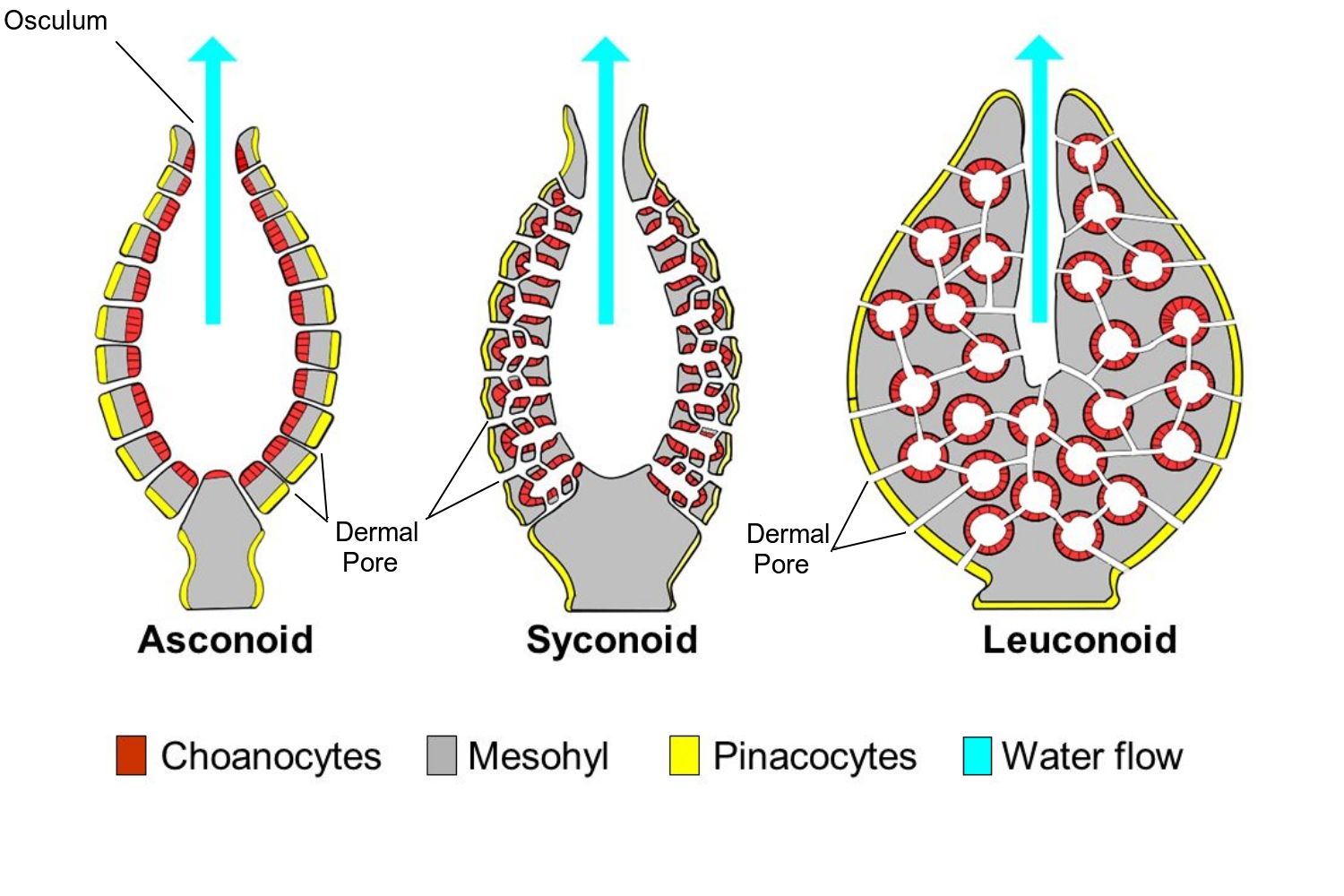
What kind of body forms can the Porifera class Calcarea have?
Can be any of the three body forms
What kind of spicules does the Porifera class Calcarea have and how many rays?
Class calcarea has calcium carbonate spicules with only 1,3, or 4 rays
Which class from the phylum Porifera consists of 80% of all sponges?
Class Demosponginea
What type of spicules does class Demosponginea have and how many rays?
They have siliceous spicules that are not 6 rayed and spongin is often present
Where is the Porifera class Hexatinellida found?
Found in the deep sea
What kind of spicules does the Porifera class Hexatinellida have and how many rays?
They have siliceous spicules with 6 rays
Which class of porifera include glass sponges?
Class Hexactinellida
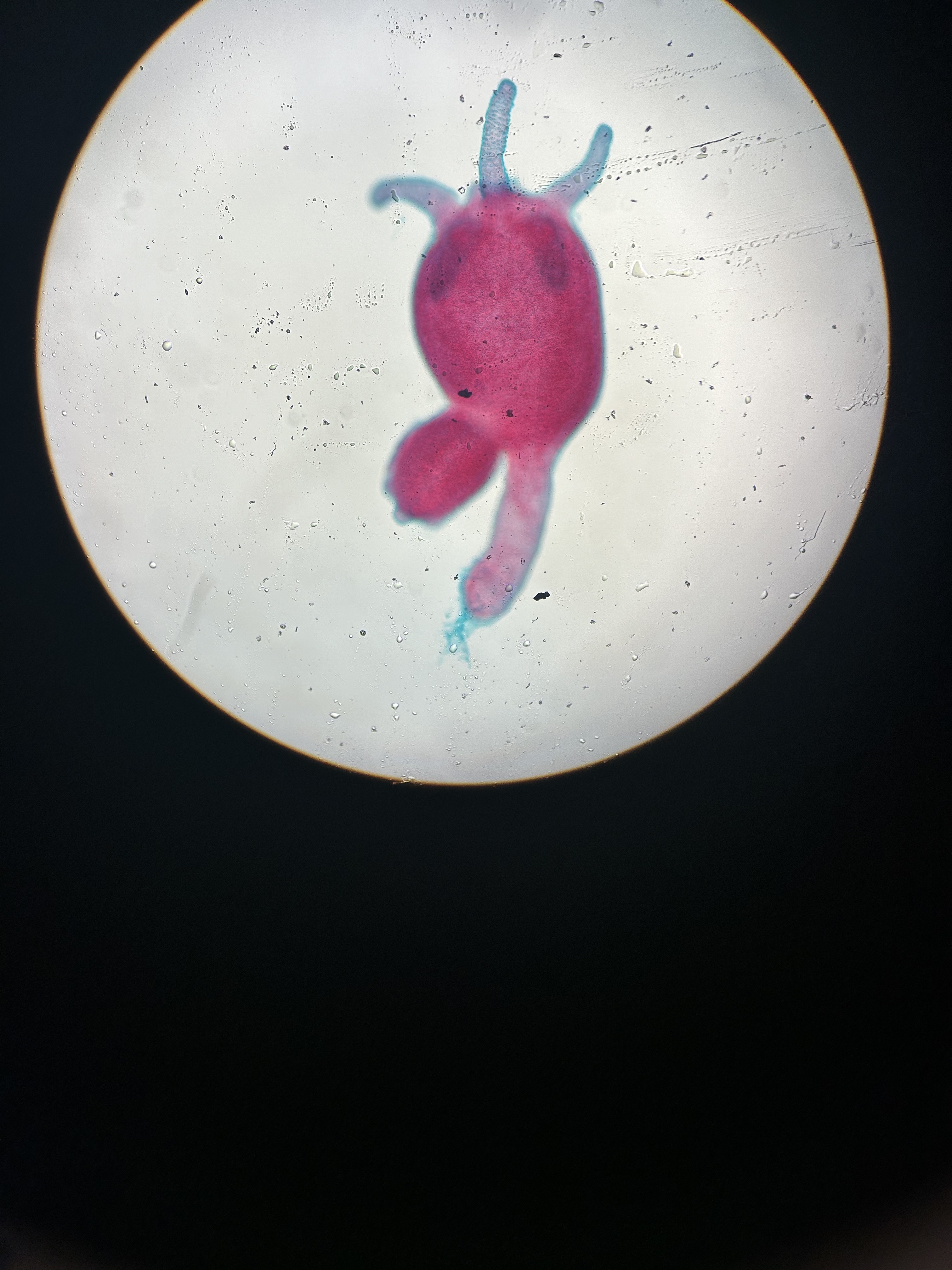
Label the following on this Hydra — ectoderm, endoderm, tentacle, gastrovascular cavity, hypostome, mouth, bud, basal disk, and cnidocils.
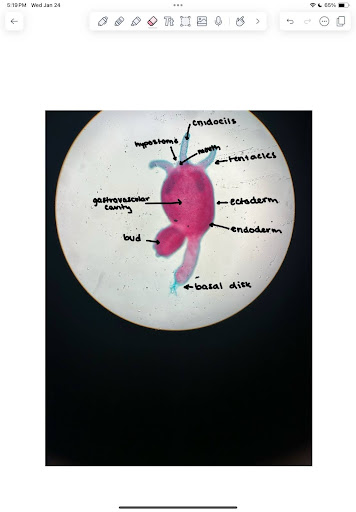
What is diploblastic?
Having 2 germ layers
What germ layers do Cnidarians have?
Epidermis derived from ectoderm and gastrodermis derived from endoderm (NO mesoderm)
What functions as the Cnidarian hydroskeleton?
mesoglea layer
What kind of symmetry do Cnidarians have?
radial
What are the body forms of Cnidarians?
2 distinct body forms - polyp (aka stalk) which is sessile and medusa (aka bell) which is free swimming
What are the main 3 classes of cnidarians?
Anthrozoa, scyphozoa, and hydrozoa
Features of a Hydrozoa — include body form, velum presence/role, and social organization
Hydrozoa
… has both polyp and medusa stages (hydromedusae are small)
…has a velum which helps with swimming and is a distinguishing characteristic for hydromedusae
… are solitary or colonial
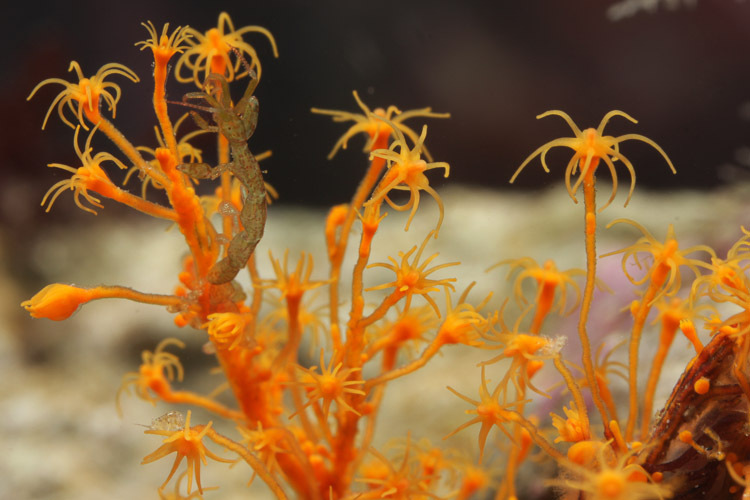
What class is hydra? What are some unique features?
Hydras are in the class Hydrozoa
They are freshwater species and solitary organisms which do both sexual and asexual reproduction
What is polymorphsm? What is the advantage of it?
When individuals of a colony have different morphologies and different functions
Polymorphism allows for different organisms to function as different parts (feeding polyp, reproductive polyp, defensive polyp) and thus divide the labor
What does it mean for a species to be colonial?
Several animals join together to form one super organism
What class is Obelia? What are some unique features?
Obelia are in the class Hydrozoa
They are marine species and colonial organisms that exhibit polymorphism. They also have an asexual polyp and a sexual medusa stage.
Features of a Scyphozia — include body form, velum presence/role, and social organization
Scyphozia
… are “true jellies” and have an emphasized medusa stage and a reduced polyp stage
… no velum (passive swimmers)
…are solitary organisms
Features of a Anthozoa — include body form and social organization
Anthozoa
… are sea anemones, corals, sea pens, sea fans
… are all polyps and have no medusa stage
… are almost always sessile
… can be solitary or colonial
What class is Metridium (sea anemone)? What are some unique features?
Metridium is apart of class anthozoa. They are larger than hydrozoan polyps and have a pedal disc for attachment. They use acontia threads for defense and prey capture and can contract tentacles and body for defense as well.
What class is coral? What are some unique features?
Coral is apart of class anthozoa. They are polyps with no pedal disc and most are colonial. They can be soft and hard and the hard corals create CaCO3 skeletons.
What are Ctenophora?
A phylum of solitary, gelatinous, marine organisms which are not jellyfish. They are considered Comb jellies.
What is the symmetry of Ctenophora?
Bilateral symmetry - they can be divided equally in only 2 plans
Do comb jellies have a complete or incomplete gut?
Unclear - have both mouth and anal pores but most food goes back out through the mouth
Are comb jellies diploblastic or triploblastic?
Unclear - they have a mesoglea with muscle fibers (more likely diploblastic)
What are the ovaries/testes in a hydra and where are they found?
Hydra are able to do both asexual and sexual reproduction. The ovaries and testes are used for sexual reproduction and are located under the ectoderm. The testes are located near the tentacles of the Hydra and the ovaries are found lower closer to the basal end of it. The testes are important for producing sperm and releasing them into the water, while the ovaries develop eggs.
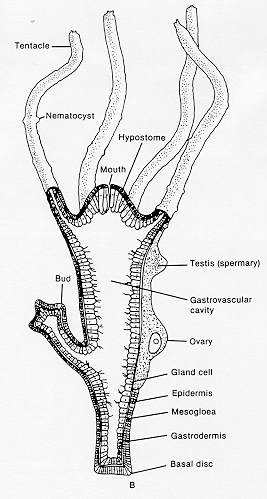
What phyla is dimorphic?
Cnidarians
What does dimorphic mean?
Dimorphic means to occur in two forms - in cnidarians it refers to the idea that they can have two different body forms in their lifetime.
Are Hydra polymorphic?
Hydra are not polymorphic.
How can a hydra do asexual reproduction?
By releasing a bud
How does a Hydra capture its prey?
If a Hydra were to capture its prey it generally does it when the prey touches its tentacle. It would send stinging cells into the prey which tend to repress them. The Hydra would then use its tentacles to draw the prey into its mouth. The prey would not struggle much since the stinging cells from the nematocysts repress its ability to move.
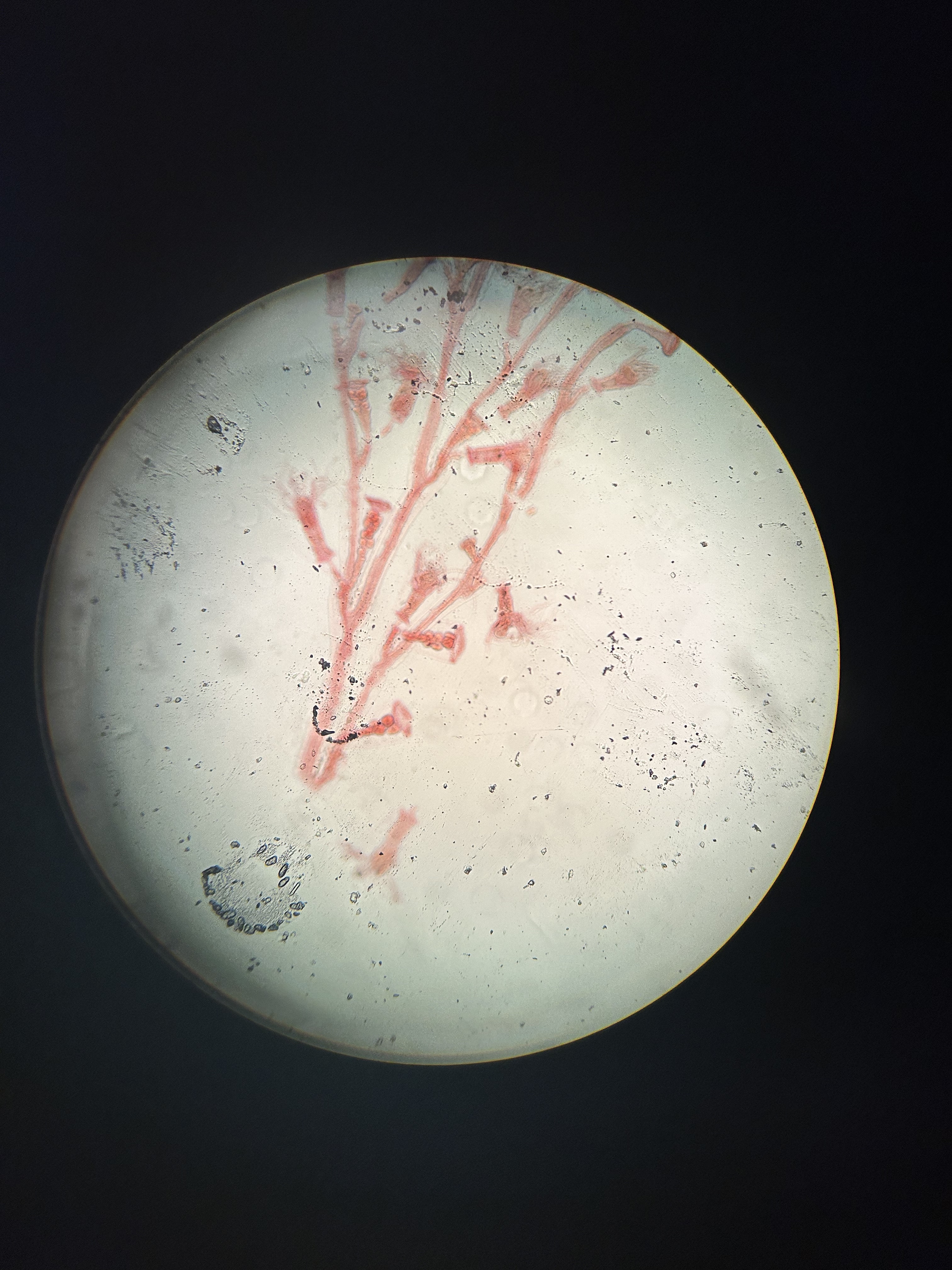
Label the following on the Obelia - tentacles, hydranth, gonangium, medusa buds, gonopore, hypostome, and mouth.

What are the functions of the different cup structures on the Obelia?
The hydranth serves as defense mechanisms and feeding structure. The gonangium serves as a reproductive structure.
Why do scyphozoan’s not have a velum?
The scyphozoan lacks a velum which is the membranous tissue covering other important structures. The velum is important because it helps organisms swim more effectively. Therefore without it the scyphozoan must not need to swim to survive. They lost this trait because they often live in a symbiotic relationship with photosynthetic algae which is why they have to lie upside down in areas with sufficient light penetration and why they do not need to be able to swim as efficiently.
How are hydromedusae different from scyphomedusae?
Hydromedusae are different compared to scyphomedusae because they are smaller and have a velum.
What is the function of nematocysts?
Nematocysts are used for defense and prey capture. These nematocysts have both a barb like feature which grabs onto the other organisms and then they can inject a toxin into them.
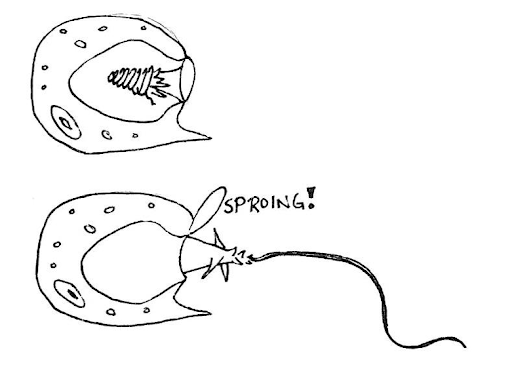
Label the following on the Cnidarian — cnidocyte, cnidocil, operculum, undischarged nematocyst, discharged nematocyst, barb, and filament.

What class of Cnidarians lack a medusa stage?
Anthozoans (sea anemones and corals)
How do sea anemones protect themselves?
They are able to contract as a defensive strategy.
They have sensors that can detect physical stimuli, and since they contract they have awareness of their surroundings, which can be an important instinct for survival.
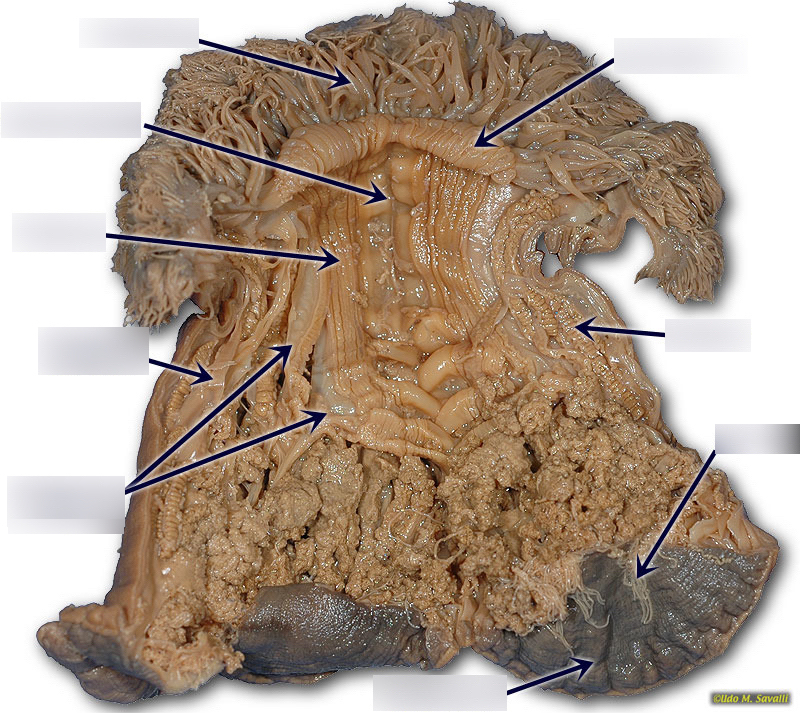
Label the following on a Metridium dissection (anthozoa) — tentacles, oral disc, pedal disc, pharynx, and acontia threads.
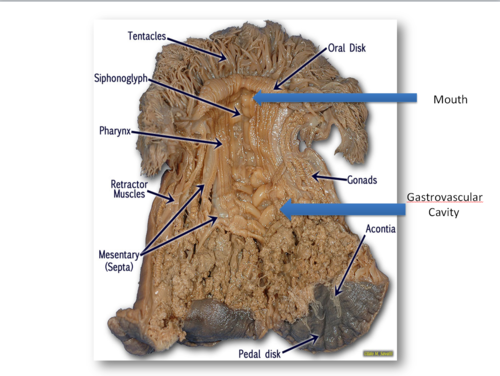
What are acontia threads?
The acontia threads are elongated septal filaments which are important for defense and prey capture. They are located in the pores of the body wall or through the mouth.
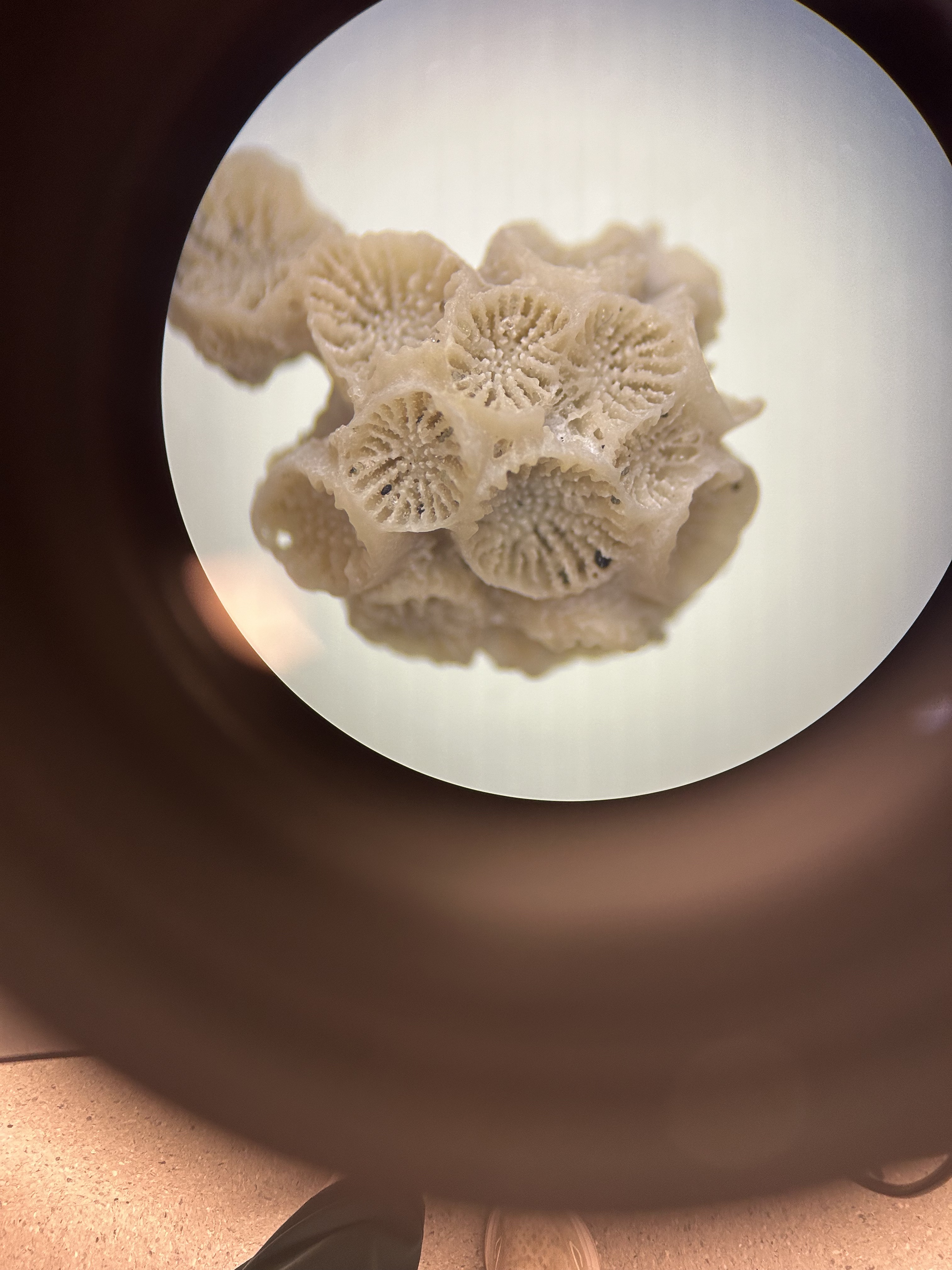
Label the following on the coral skeleton — corallite, sclerosepta (septa), and columella.
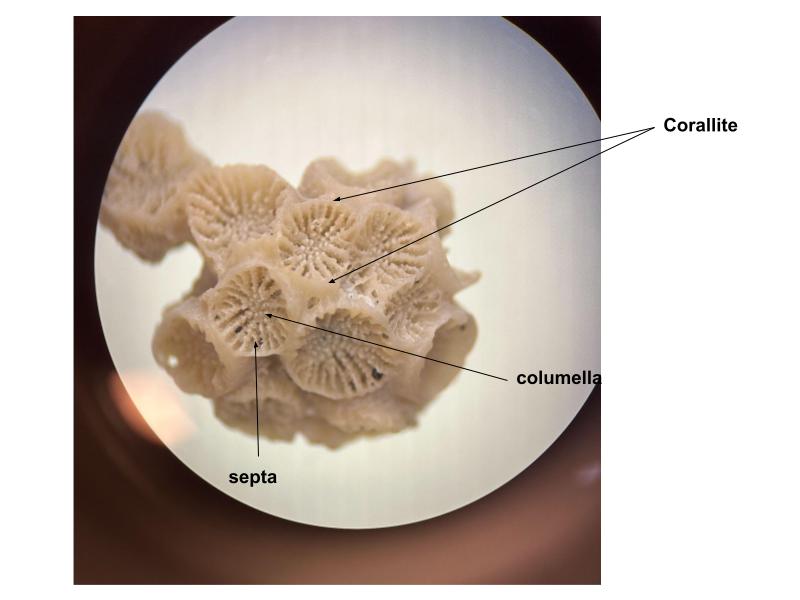
How is ocean acidification affecting corals?
The acidification dissolves the calcium carbonate in the coral which makes them disintegrate/dissolve in the way that was seen in our coral.
Ocean acidification also impacts coral by harming the algae in which they share a symbiotic relationship with and thus the algae fall off the coral causing them to bleach and turn white. Without these algae the corals cannot survive and will eventually die causing many more species to not be able to thrive without the habitat and resources that corals provide.
Label the following on a Ctenophora —- mesoglea, comb row, and ctene/comb.
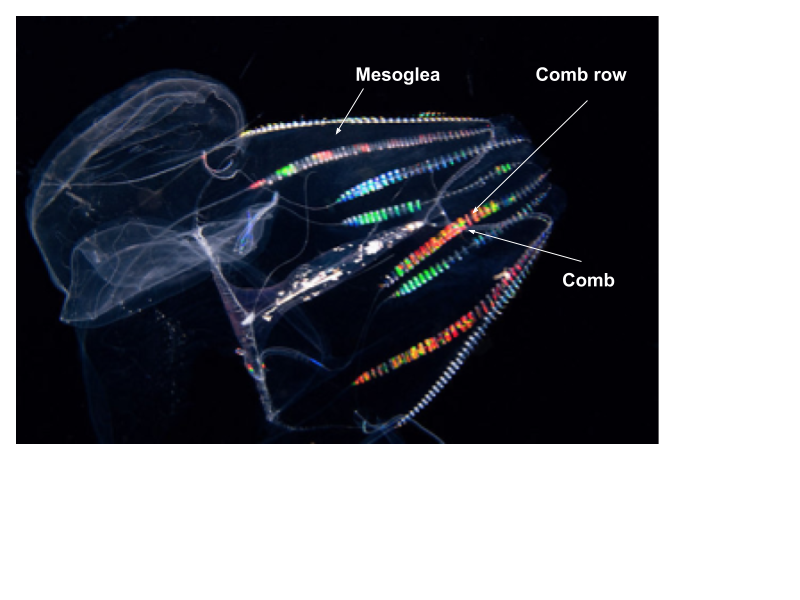
What are the 8 comb rows made of? What is their function?
Comb rows are made of ctenes which are ciliated comb plates used for locomotion
Do Ctenophora have nematocysts?
No but they have colloblasts which are adhesive cells to capture prey
What are two differences that separate cnidarians and ctenophores?
Ctenophores have no polyp form and bilateral symmetry, while cnidarians have a polyp form and radial symmetry.
How many germ layers do Platyhelminthes and Rotifera have?
3 germ layers - triploblastic body plans
What symmetry do Rotifers and Platyhelminthes have?
Bilateral symmetry
What is cephalization?
Distinct head region with brain-like organ
What is a protostome?
An organisms which the mouth develops from the blastopore
What kind of muscles do Platyhelminthes have?
Circular and Longitudinal muscles
What kind of structure do Platyhelminthes have?
They have a hydroskeleton with fluid in between/underneath the mesoderm
How do Platyhelminthes transport nutrients?
Via diffusion - no respiratory or circulatory systems
What type of sexual system are Platyhelmines?
Monoecious (hermaphroditic)
How do Platyhelmines excrete wastes?
Via flame cells
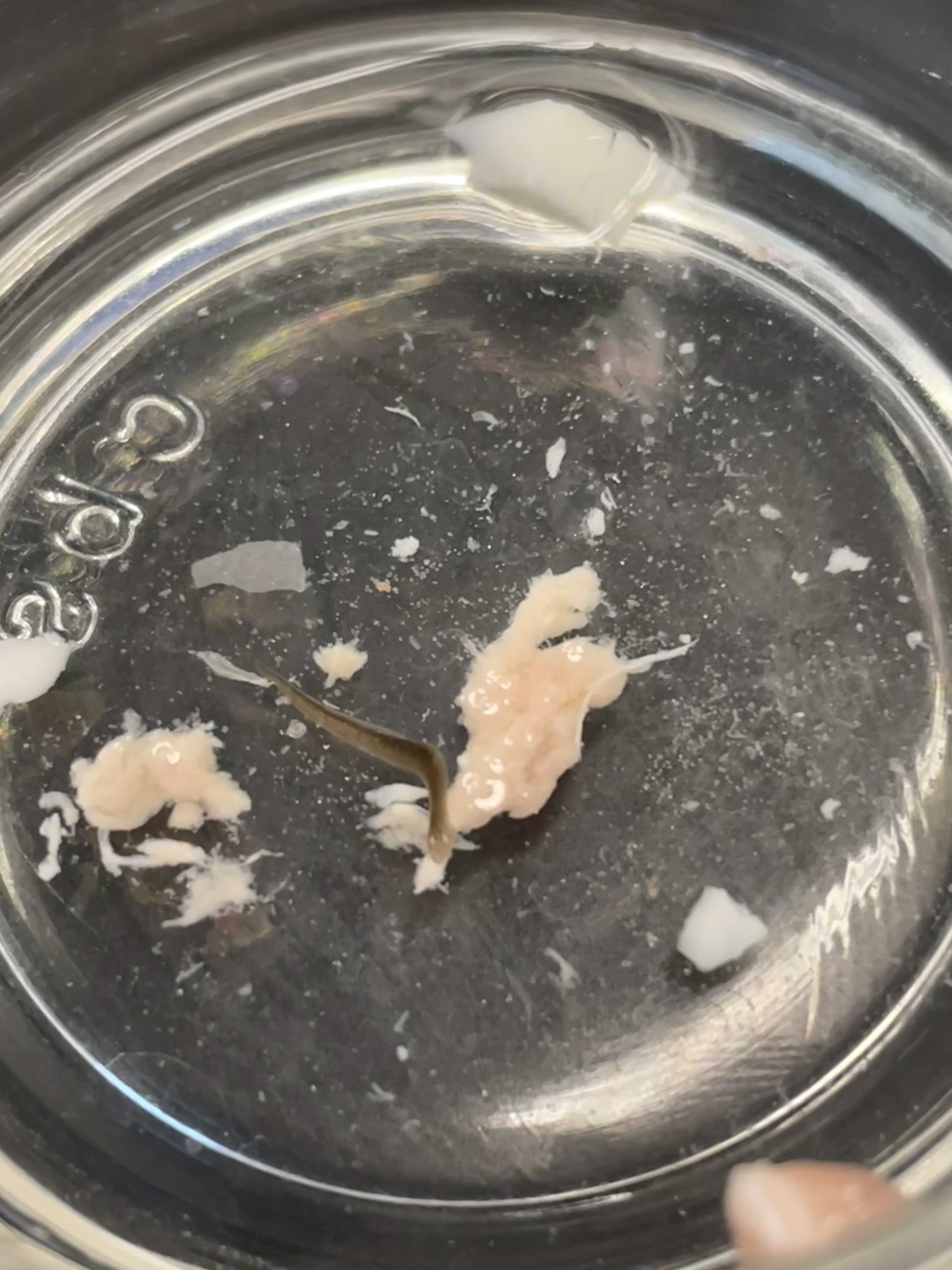
Label the Pharynx, Ocelli, and Auricles of the planarian
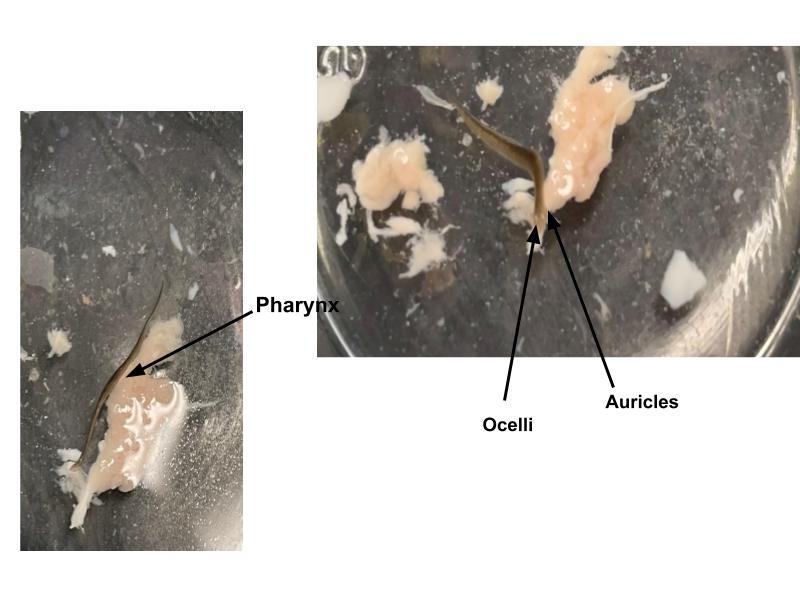
What was the most common food selected by the planarians in the class? Why?
Raw Ground Meat - greater protein content?
Describe the planarian’s digestive process. How is it similar to cnidarians?
Planarians are carnivorous organisms which have an incomplete gut and a gastrovascular cavity which is similar to cnidarians.